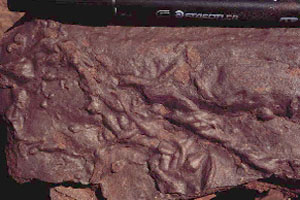| Terreneuvian Epoch | ||
| Paleozoic: Cambrian Period |
Fortunian Age |
| Terreneuvian | ||||
| Tommotian | Cambrian Epoch 2 | Timescale |
Neoproterozoic Era |
Also known as the Manykaian or Manikajan (etc.), the Fortunian is the earliest of the five Siberian Early Cambrian ages, and also the most recently recognized. The stage and its equivalents were only added to the Cambrian in 1992.
It is characterized by the first appearance of small shelly faunas (SSFs). The SSFs appear sequentially and diversify slowly, but it is not until the following, Tommotian stage that they really take off. They are the earliest well-known complex three-dimensional trace fossils; mostly small, chitinous, calcareous, and phosphatic elements of problematic affinity. Some of them at least formed part of the armour of larger (more normal sized) invertebrate animals; the so-called "coat of mail" creatures like Halkeria

Fig. 1: The horizontal burrow trace fossil, Trichophycus pedum defines the lower boundary of the Cambrian in the reference section at Fortune Head, southeastern Newfoundland. [Image courtesy of Dr. Gerd Geyer, Institut für Paläontologie, Bayerische Julius-Maximilians-Universität, Würzburg, Germany.]
The Fortunian is also represented by the first good infaunal trace fossils. The base of the stage is marked by the FAD (First Appearance Datum) of the of burrowing trace fossil Trichophycus pedum (formerly Phycodes pedum), shown above. This event is dated radiometrically at about 544 Ma, and is thus older (by about 15 million years or more) than the Tommotian-Atdabanian "Cambrian Explosion" proper.
page uploaded 15 May 2002
checked ATW060102